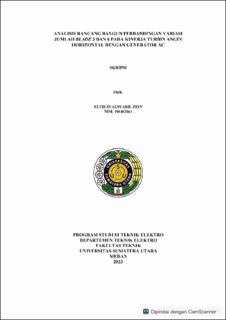| dc.description.abstract | Wind originates from moving air, and it blows due to differences in temperature and pressure. The wind moves from high-pressure areas to low-pressure areas due to changes in atmospheric temperature and pressure. Wind turbines harness the energy of the blowing wind, impacting the turbine blades, causing the rotor to spin. The rotation of the rotor is connected to a generator, resulting in the rotation of the generator rotor and the generation of electricity. Therefore, wind speed influences the rotation of the rotor and the blades of the turbine. This thesis aims to make a comparison of the optimal effects of 3 and 6 blades on horizontal wind turbines. In this final project, the design involves a horizontal wind turbine with an AC generator rectified by a diode rectifier circuit. The blade design includes a blade length of 57 cm, a bottom width of 10 cm, and a tip width of 5 cm. Wind at speeds of 3 m/s, 3.5 m/s, 4 m/s, 4.5 m/s, and 5 m/s is applied to the horizontal wind turbine generated by a wind generator in the Lab. Terpadu. Results from the research include findings during battery charging, DC load, and AC load tests. In battery charging tests, using a 3-blade wind turbine, the highest voltage obtained is 31.31 volts with a produced current of 0.15 amperes. Meanwhile, with a 6-blade wind turbine the highest voltage is 33.31 volts, producing 0.15 amperes. When subjected to a DC load. the highest voltage using a 3-blade turbine is 32.96 volts, with a current of 0.18 amperes. In comparison, the 6-blade turbine reaches a voltage of 39.23 volts, producing a current of 0.18 amperes. Under AC load, the highest voltage using a 3-blade turbine is 23.27 volts with a current of 0.18 amperes. Using a 6-blade turbine, the highest voltage is 30.93 volts, producing a current of 0.17 amperes. The experiments were conducted at a wind speed of 5 m/s. The generated electrical energy is stored in a 12-volt. 6 Ah battery to power DC lamps and an inverter for AC loads. | en_US |


